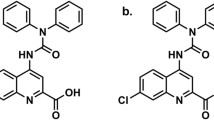Abstract
We describe here biochemical and pharmacological effects of the β-carboline ZK 93426, a new and potent benzodiazepine (BZ) receptor antagonist. ZK 93426 was compared with Ro 15-1788 and CGS 8216, two compounds previously described as BZ receptor antagonists. Certain effects of ZK 93426, Ro 15-1788 and CGS 8216 were quite similar (e.g., 3H-FNM displacement, “GABA ratio”, “photo-shift”). In most pharmacological tests ZK 93426 and Ro 15-1788 lacked overt effects; Ro 15-1788 was a weak agonist in some paradigms, while ZK 93426 exhibited a potent proconflict effect but also a weak anticonvulsant effect. This interesting finding with ZK 93426 suggests that BZ receptor ligands may possess differential efficacy at BZ receptor subtypes. In contrast, CGS 8216 exhibited potent proconvulsant effects in several paradigms in addition to proconflict and pentylenetetrazol generalizing effects. ZK 93426, Ro 15-1788 and CGS 8216 were almost equally potent as antagonists of the effects of BZ receptor agonists, such as diazepam and lorazepam. However, ZK 93426 was the most potent inhibitor of the convulsions produced by the BZ receptor inverse agonist DMCM.
Similar content being viewed by others
References
Albertson TE, Bowyer JF, Paule MG (1982) Modification of the anticonvulsant efficacy of diazepam by Ro 15-1788 in the kindled amygdaloid seizure model. Life Sci 31:1597–1601
Bernard P, Bergen K, Sobiski R, Robson RD (1981) CGS 8216 (2-Phenylpyrazolo[4,3-c]quinoline-3(5H)-one), an orally effective benzodiazepine antagonist. Pharmacologist 23:150
Boissier JR, Simon P, Aron C (1968) A new method for rapid screening of minor tranquillizers in mice. Eur J Pharmacol 4:145–150
Bonetti EP, Pieri L, Cumin R, Schaffner R, Pieri M, Gamzu ER, Müller RKM, Haefely W (1982) Benzodiazepine antagonist Ro 15-1788: Neurological and behavioral effects. Psychopharmacology 78:8–18
Braestrup C, Schmiechen R, Neff G, Nielsen M, Petersen EN (1982) Interaction of convulsive ligands with benzodiazepine receptors. Science 216:1241–1243
Braestrup C, Nielsen M, Honoré T (1983) Binding of [3H]-DMCM, a convulsive benzodiazepine ligand to rat brain membranes. Preliminary studies. J Neurochem 41:454–464
Chang RSL, Snyder SH (1978) Benzodiazepine receptors: Labelling in intact animals with [3H]flunitrazepam. Eur J Pharmacol 48:213–218
Colpaert FC (1977) Discriminative stimulus properties of benzodiazepines and barbiturates. In: Lal H (ed) Discriminative stimulus properties of drugs. Plenum, New York, pp 93–106
Corda MG, Costa E, Guidotti A (1982) Specific proconvulsant action of an imidazobenzodiazepine (Ro 15-1788) on isoniazid convulsions. Neuropharmacology 21:91–94
Corda MG, Blaker WD, Mendelson WB, Guidotti A, Costa E (1983) β-Carbolines enhance shock-induced suppression of drinking in rats. Proc Natl Acad Sci USA 80:2072–2076
Czernik AJ, Petrack B, Kalinsky HJ, Psychoyos S, Cash WD, Tsai C, Rinehart RK, Granat FR, Lovell RA, Brundish DE, Wade R (1982) CGS 8216: Receptor binding characteristics of a potent benzodiazepine antagonist. Life Sci 30:363–372
Dantzer R, Perio A (1982) Behavioural evidence for partial agonist properties of Ro 15-1788, a benzodiazepine receptor antagonist. Eur J Pharmacol 81:655–658
Dixon WJ, Mood AM (1948) A method for obtaining and analysing sensitivity data. J Am Statist Assoc 43:109–112
Dorow R, Horowski R, Paschelke G, Amin M, Braestrup C (1983) Severe anxiety induced by FG 7142, a β-carboline ligand for benzodiazepine receptors. Lancet II:98
Ehlert FJ, Roeske WR, Braestrup C, Yamamura SH, Yamamura HI (1981) γ-Aminobutyric acid regulation of the benzodiazepine receptor: Biochemical evidence for pharmacologically different effects of benzodiazepines and propyl β-carboline-3-carboxylate. Eur J Pharmacol 70:593–596
File SE, Lister RG (1983) Quinolines and anxiety: Anxiogenic effects of CGS 8216 and partial anxiolytic profile of PK 9084, Pharmacol. Biochem Behav 18:185–188
File SE, Lister RG, Nutt DJ (1982) The anxiogenic action of benzodiazepine antagonists. Neuropharmacology 21:1033–1037
Honoré T, Nielsen M, Braestrup C (1984) Barbiturate shift as a tool for determination of efficacy of benzodiazepine receptor ligands. Eur J Pharmacol 100:101–108
Hunkeler W, Möhler H, Pieri L, Polc P, Bonetti EP, Cumin R, Schaffner R, Haefely W (1981) Selective antagonists of benzodiazepines. Nature 290:514–516
Jensen LH, Petersen EN, Braestrup C (1983) Audiogenic seizures in DBA/2 mice discriminate sensitively between low efficacy benzodiazepine receptor agonists and inverse agonists. Life Sci 33:393–399
Jensen LH, Petersen EN (1983) Bidirectional effects of benzodiazepine receptor ligands against picrotoxin-and pentylenetetrazol-induced seizures. J Neural Transm 58:183–191
Karobath M, Supavilai P (1982) Distinction of benzodiazepine agonists from antagonists by photoaffinity labelling of benzodiazepine receptors in vitro. Neurosci Lett 31:65–69
Litchfield JT, Wilcoxon F (1948) A simplified method of evaluating dose-effect experiments. J Pharmacol Exp Ther 96:99–103
Mendelson WB, Davis T, Paul SM, Skolnick P (1983) Do benzodiazepine receptors mediate the anticonflict action of pentobarbital? Life Sci 32:2241–2246
Nutt DJ, Cowen PJ, Little HJ (1982) Unusual interactions of benzodiazepine receptor antagonist. Nature 295:436–438
Oakley NR, Jones BJ (1980) The proconvulsant and diazepamreversing effects of ethyl-β-carboline-3-carboxylate. Eur J Pharmacol 68:381–382
Petersen EN, Paschelke G, Kehr W, Nielsen M, Braestrup C (1982) Does the reversal of the anticonflict effect of phenobarbital by β-CCE and FG 7142 indicate benzodiazepine receptor mediated anxiogenic properties? Eur J Pharmacol 82:217–221
Petersen EN (1983) DMCM: A potent convulsive benzodiazepine receptor ligand. Eur J Pharmacol 94:117–124
Polc P, Bonetti EP, Schaffner R, Haefely W (1982) A three-state model of the benzodiazepine-receptor explains the interaction between the benzodiazepine antagonist Ro 15-1788, benzodiazepine tranquilizers, β-carbolines, and phenobarbitone. Arch Pharmacol 321:260–264
Schweri M, Cain M, Cook J, Paul S, Skolnick P (1982) Blockade of 3-carbomethoxy-β-carboline induced seizures by diazepam and the benzodiazepine antagonists, Ro 15-1788 and CGS 8216. Pharmacol Biochem Behav 17:457–463
Shearman D, Lal H (1979) Discriminative stimulus properties of pentylenetetrazol and bemegride: Some generalization and antagonism tests. Psychopharmacology 64:315–319
Valin A, Dodd RH, Liston DR, Potier P, Rossier J (1982) Methyl-β-carboline-induced convulsions are antagonized by Ro 15-1788 and by propyl-β-carboline. Eur J Pharmacol 85:93–97
Author information
Authors and Affiliations
Rights and permissions
About this article
Cite this article
Jensen, L.H., Petersen, E.N., Braestrup, C. et al. Evaluation of the β-carboline ZK 93 426 as a benzodiazepine receptor antagonist. Psychopharmacology 83, 249–256 (1984). https://doi.org/10.1007/BF00464789
Received:
Accepted:
Issue Date:
DOI: https://doi.org/10.1007/BF00464789




